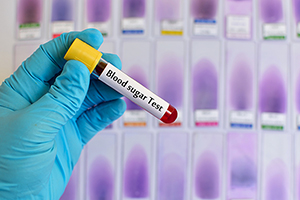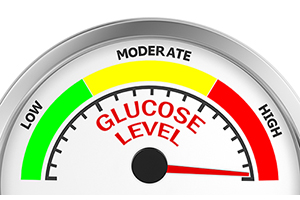Americans love to “carbo-load.” We are a society in love with carbohydrates—and it shows in our poor health standing versus some of the other industrialized nations of the world. According to the Centers for Disease Control and Prevention, diabetes contributed to a total of 224,092 deaths in 2002—all stemming from poor eating habits (source: www.cdc.gov). But Americans don’t get their nutrition information from the government or even from their doctors — they get it from advertising. Though we talk up things like fiber, what is often palmed off as a high-fiber food is a highly refined commercial “brown” bread made of food coloring and white flour in a wrapper depicting a log cabin on the front —a far cry from the fiber intake of our Stone-Age ancestors: roots, shoots, foliage and occasional berries.
In essence, hypoglycemia is low blood sugar, and it is increasingly prevalent in our society. Hypoglycemia can cause an array of symptoms, including dizziness, fatigue, mood changes, PMS, sugar cravings, headaches, difficulty concentrating, tremors, temperamental outbursts, depression, excessive sweating, hot flashes, palpitations, cold extremities, abdominal pain and panic attacks.
If you have any of these symptoms, the next time you go to a doctor try asking him or her if the symptoms you experience could be due to hypoglycemia. You may provoke a bemused or annoyed look, or perhaps your doctor will, in fact, suggest a glucose tolerance test. Don’t bother. Glucose tolerance tests, as performed conventionally, are not designed to detect hypoglycemia until or unless it has reached a very extreme level.
The truth is that hypoglycemia is far more prevalent than we’re led to believe. Studies show that even in its full-blown form it often is misdiagnosed. Consider this example: In one study of 39 patients who had tumors in the pancreas, a condition causing profound hypoglycemia, eight were first diagnosed with epilepsy or neurosis! Detection and diagnosis of hypoglycemia can lead to treatment that can totally correct this condition. Even if the symptoms are vague and seemingly subjective (which makes most doctors want to shy away from this diagnosis), if you’re the one experiencing them, they can destroy the quality of your life.
Why so many different kinds of symptoms? To learn the answer to that, we have to explore the physiology of low blood sugar.
The body is designed to digest and assimilate three primary nutrients: proteins, fats and carbohydrates. Proteins and fats can be used for energy, but their conversion to forms usable by the body is gradual, not immediate. By contrast, carbohydrates are all more or less readily digested into sugar. Low-glycemic carbohydrates such as many vegetables and beans provide a slow time-release of the sugar they contain in their complex molecules of starch mixed with fiber. The presence of natural starch-blockers in beans further slows the sugar liberation process. This is why if you have bean soup for lunch you probably won’t feel hungry till dinner.
On the other hand, sugars and refined carbohydrates provide a rapid sugar fix. This results in an immediate, pleasant sense of gratification, sometimes even a mild drowsiness. It’s the familiar sugar high. But then, in response to so much sugar in the blood, the body calls upon its insulin reserves, generated by the pancreas, to lower the blood sugar. This often happens precipitously, sometimes with crashing rapidity.
Experiments have now confirmed what the hypoglycemic person experiences. Low blood sugar triggers hunger—especially carbohydrate craving. In addition, the brain is starved for its preferred fuel: glucose. At rest, the brain consumes one-third of the body’s total glucose requirement. The brain is a hungry, rapidly metabolizing organ, and fuel shortages in it create problems with concentration, memory and mood. A recent study showed that individuals with low blood sugar scored poorly on tasks requiring memory, concentration and reasoning.
But perhaps most important, low blood sugar triggers an outpouring of counter-regulatory hormones (catecholamines) from the adrenals. These hormones oppose the action of insulin and push blood sugar levels back up. Unfortunately for the hypoglycemic person, these “rescue” hormones are the very same ones that produce the adrenaline rush of a fight-or-flight reaction. The results are symptoms including palpitations, sweaty palms, nervousness, tremor and sometimes even severe panic attacks.
If you think you suffer from blood sugar swings, what can you do? The best idea is to test yourself by going off sugar completely. Ultimately, it’s the way that works best. The results can seem quite disastrous at first. Many of my patients report a week of severe fatigue and almost supernatural cravings for sugar. Their concentration may be affected, and they may feel fidgety, irritable and deeply depressed. I’m often inundated with phone calls in that first week. Some of them will be very resourceful in trying to sneak sugar into their diets. “Gee, Doc,” a patient will say, “I just found something in the health food store called barley malt. And rice syrup. Those are OK, aren’t they?” Actually they’re not. Along with honey, maple syrup, dextrin, maltose, Sucanat, fructose, corn syrup, sugar cane syrup, organic cane juice and molasses, they are simply alternative forms of sugar and should all be avoided when you are going off sugar completely. Note, too, that when manufacturers use the term sugar-free or sugarless, they generally mean that no sucrose is added, but other sugars may be.
I don’t relish being a food policeman. We should all do our own self-policing if we are going to kick the sugar habit. This initial period of withdrawal is sometimes tough because sugar is as addictive as any drug. In fact, I have a hunch that the same hereditary susceptibility that leads to alcoholism may be involved in sugar addiction. Virtually all recovering alcoholics become carboholics. One study published in the American Journal of Clinical Nutrition found that alcoholics don’t consume that much sugar until they withdraw from alcohol. And another study recently showed that alcoholics favor high-sugar beverages at three times the rate of non-alcoholics. Many of my patients who are “carboholics” have a family history of alcoholism. “I don’t drink alcohol, Dr. Hoffman. We’ve had enough of that in our family.” Yet, they are addicted to sugar.
According to remarkable studies by Judith and Richard Wurtman of MIT, sugar tends to change the way the blood-brain barrier selects the appropriate amino-acid building blocks of brain chemicals. Carbohydrate intake promotes uptake of the amino acid tryptophan, which is the building block for a brain chemical called serotonin. Serotonin is a proven tranquilizer. Certain individuals suffer major depression as a result of low levels of serotonin in the brain.
Because sugar may combat depression, some researchers suggest using sugary snacks to “feed” the brain as a therapy. I disagree. My belief is that sugar perpetuates a cycle of craving and bingeing. I would recommend tryptophan (which was formerly a treatment for depression, particularly in Great Britain), but because of a much-publicized incident of tryptophan contamination that resulted in tragic poisoning, this amino acid was taken off the market in 1989. The subsequent popularity of the Prozac family of antidepressants attests to the primacy of serotonin in the biochemistry of well-being. Unfortunately, these medications bring with them many undesirable side effects such as dry mouth, drowsiness, visual disturbances and weight gain.
There is an alternative, however. A recent study suggests the mineral chromium, found in such foods as meat, broccoli, apples and whole grains, may be useful in treating atypical (common) depression, particularly when carbohydrate cravings are present. Chromium enhances the action of insulin, which delivers glucose to the cells thereby stabilizing blood sugar, which is key in regulating mood and diminishing cravings. There also is ample scientific evidence that asserts that chromium reduces risk factors for heart disease in individuals with type 2 diabetes. In fact, a deficiency in chromium is shown to cause disturbances in lipid metabolism, elevating triglycerides and LDL cholesterol in the blood and decreasing HDL. Such a deficiency also disrupts carbohydrate metabolism, inducing hypoglycemia and impaired glucose tolerance.
There’s more good news: Clinical findings show a reduction in carbohydrate cravings and improvement in energy levels in as little as one day of beginning a chromium supplement regimen. It is worth mentioning that additional vitamin C increases the absorption of this important mineral. Recommended doses are between 3 and 5 micrograms (mcg) of chromium picolinate per pound of body weight, preferably under the supervision of an experienced physician or nutritionist.
By far, the best answer is to switch to a diet emphasizing protein, healthy fats and low-glycemic carbohydrates, which provides the body with slowly released and steady levels of blood sugar. This attests to the value of nutrition and supplementation in the treatment of hypoglycemia.






